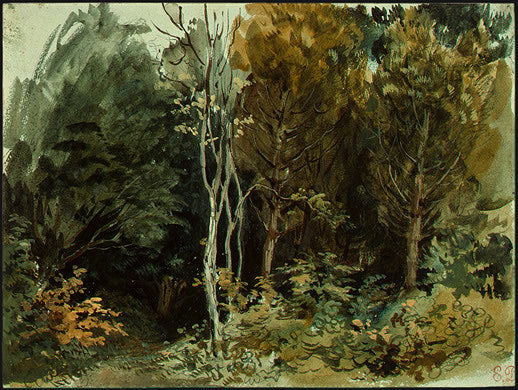Description
The painting "The Edge of a Forest at Nohant" (1843) by Eugène Delacroix is one of those works that stands out not only for its aesthetic beauty, but also for the emotional depth and technical mastery of the artist. Delacroix, known as one of the main exponents of French Romanticism, achieved in this work an impeccable synthesis between light and shadow, reflecting an intimate connection between man and nature.
When examining “The Edge of a Forest at Nohant,” the composition reveals itself as a testament to the artist’s romantic approach to landscape. The work depicts a lush forest, whose dense vegetation is projected with vigor and life, while the light filtered through the leaves creates an almost ethereal effect. Delacroix employs a color palette that moves between dark and light greens, complemented by accents of yellow and blue that suggest the prevalence of light in this natural space. This interplay of hues gives the work a sense of vibration and movement, inviting the viewer to feel part of that environment.
The use of light is particularly notable. Delacroix, through his technique of loose and dynamic brushstrokes, captures the effects of natural light passing through the foliage, creating a contrast between the illuminated areas and the deeper shadows found at the edge of the forest. This play of light not only brings depth to the composition, but also suggests a sense of mystery, evoked by the shadowy areas intertwining with the illuminated zones.
Although The Edge of a Forest in Nohant does not feature explicit human figures, the context of nature suggests an emotional presence, perhaps representing a search for refuge or contemplation. The absence of characters can be interpreted as a dialogue between the viewer and nature itself, where the silence of the forest alludes to the introspection and personal connection that the scene can evoke. This approach is characteristic of Romanticism, where personal and emotional experience overtakes the narrative.
The use of nature as a mirror of human afflictions is also found in other contemporary works by Delacroix, as well as those of other Romantic artists. The loose brushstrokes and vibrant atmosphere he conjures up in this piece could be compared, in terms of technique, to the work of artists such as John Constable and JMW Turner, who also explored the tensions between light and nature in their landscapes.
In terms of context, it is important to remember that this work was produced during a period of intense artistic exploration by Delacroix, who was experimenting with different techniques and forms of expression. His ability to fuse colour and light shows his mastery, whilst also looking forward to the evolution of art towards Impressionism.
"The Edge of a Forest at Nohant" not only captures the essence of the natural landscape, but also acts as a testament to the 19th century Romantic sensibility, where nature is perceived as a vital context for human experience. The work remains as a reminder of the inherent beauty in natural spaces and their ability to evoke deep emotions in the viewer, reinforcing Delacroix's legacy as a pioneer in the exploration of colour and light in art.
KUADROS ©, a famous painting on your wall.
Hand-made oil painting reproductions, with the quality of professional artists and the distinctive seal of KUADROS ©.
Painting reproduction service with satisfaction guarantee. If you are not completely satisfied with the replica of your painting, we will refund 100% of your money.

